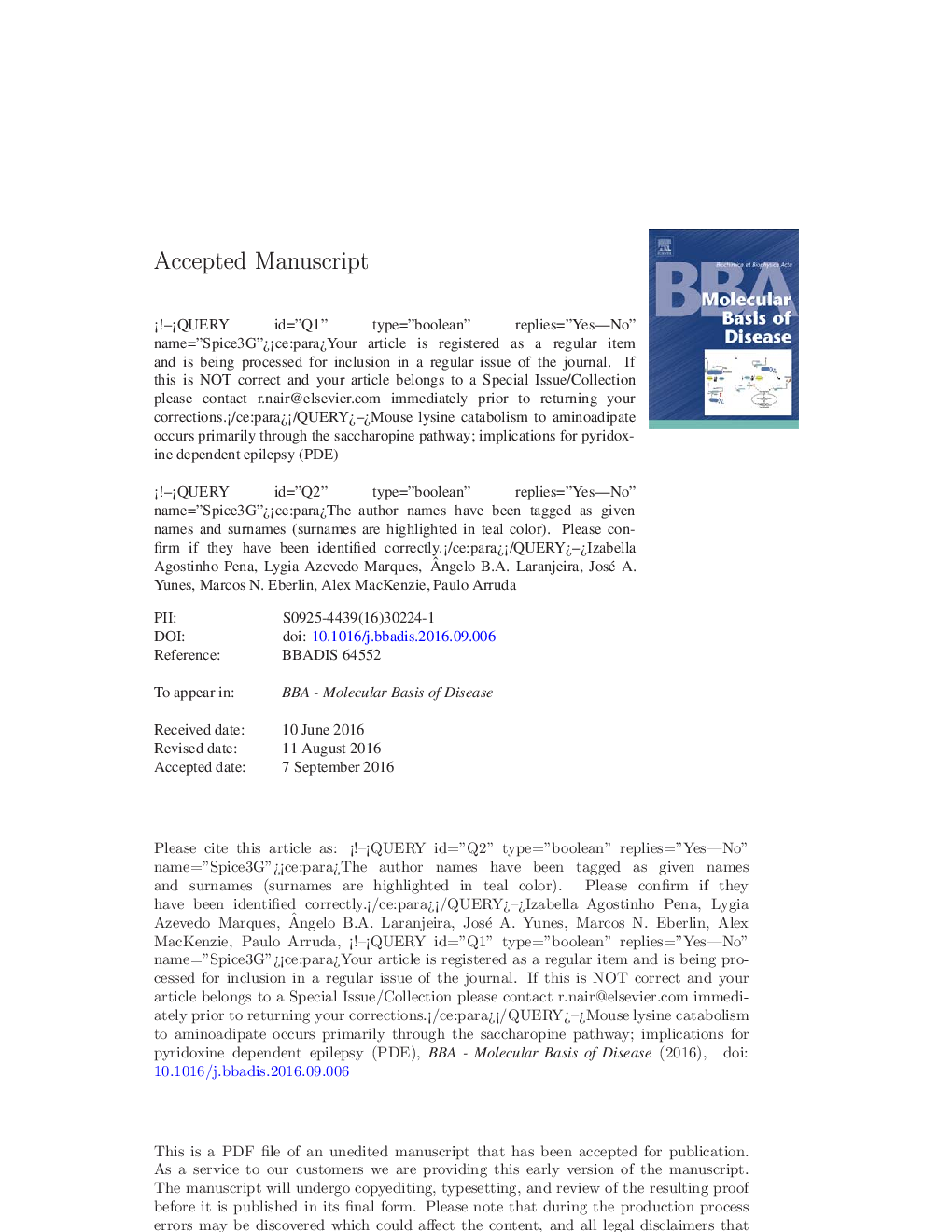| کد مقاله | کد نشریه | سال انتشار | مقاله انگلیسی | نسخه تمام متن |
|---|---|---|---|---|
| 5501170 | 1534626 | 2017 | 28 صفحه PDF | دانلود رایگان |
عنوان انگلیسی مقاله ISI
Mouse lysine catabolism to aminoadipate occurs primarily through the saccharopine pathway; implications for pyridoxine dependent epilepsy (PDE)
دانلود مقاله + سفارش ترجمه
دانلود مقاله ISI انگلیسی
رایگان برای ایرانیان
موضوعات مرتبط
علوم زیستی و بیوفناوری
بیوشیمی، ژنتیک و زیست شناسی مولکولی
سالمندی
پیش نمایش صفحه اول مقاله

چکیده انگلیسی
Lysine is catabolized in mammals through the saccharopine and pipecolate pathways - the former is mainly hepatic and renal, and the latter is believed to play a role in the cerebral lysine oxidation. Both pathways lead to the formation of aminoadipic semialdehyde (AASA) that is then oxidized to aminoadipate (AAA) by antiquitin (ALDH7A1). Mutations in the ALDH7A1 gene result in the accumulation of AASA and its cyclic form, piperideine-6-carboxylate (P6C), which causes pyridoxine-dependent epilepsy (PDE). P6C reacts with pyridoxal 5â²-phosphate (PLP) causing its inactivation. Here, we used liquid chromatography-mass spectrometry to investigate lysine catabolism in mice injected with lysine labelled at either its nitrogen epsilon (ε-15N) or nitrogen alpha (α-15N). Analysis of ε-15N and α-15N lysine catabolites in plasma, liver and brain suggested the saccharopine as the main pathway for AAA biosynthesis. Although there was evidence for upstream cerebral pipecolate pathway activity, the resulting pipecolate does not appear to be further oxidized into AASA/P6C/AAA. By far the bulk of lysine degradation and therefore, the primary source of lysine catabolites are hepatic and renal. The results indicate that the saccharopine pathway is primarily responsible for body's production of AASA/P6C. The centrality of the saccharopine pathway in whole body lysine catabolism opens new possibilities of therapeutic targets for PDE. We suggest that inhibition of this pathway upstream of AASA/P6C synthesis may be used to prevent its accumulation benefiting PDE patients. Inhibition of the enzyme aminoadipic semialdehyde synthase, for example, could constitute a new strategy to treat PDE and other inherited diseases of lysine catabolism.
ناشر
Database: Elsevier - ScienceDirect (ساینس دایرکت)
Journal: Biochimica et Biophysica Acta (BBA) - Molecular Basis of Disease - Volume 1863, Issue 1, January 2017, Pages 121-128
Journal: Biochimica et Biophysica Acta (BBA) - Molecular Basis of Disease - Volume 1863, Issue 1, January 2017, Pages 121-128
نویسندگان
Izabella Agostinho Pena, Lygia Azevedo Marques, Ãngelo B.A. Laranjeira, José A. Yunes, Marcos N. Eberlin, Alex MacKenzie, Paulo Arruda,